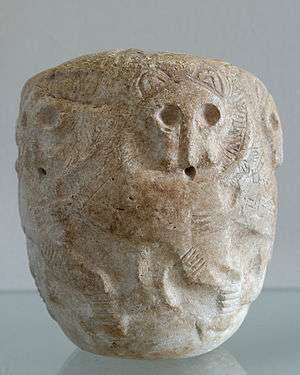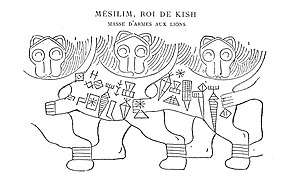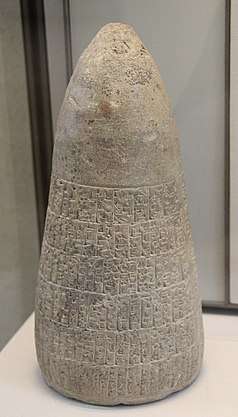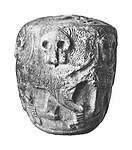Mesilim
Mesilim (Sumerian: 𒈨𒁲),[3] also spelled Mesalim (c. 2600 BC), was lugal (king) of the Sumerian city-state of Kish.
| Mesilin 𒈨𒁲 | |
|---|---|
| King of Kish | |
  Head of a votive mace with a lion-headed eagle (emblem of god Ningirsu) and six lions, dedicated at a shrine in Girsu by King Mesilim of Kish. Inscription in archaic script: “Mesilim, king of Kish, builder of the temple of Ningirsu, brought [this mace head] for Ningirsu, Lugalshaengur [being] prince of Lagash”.[1] Louvre Museum.[2] | |
| Reign | c. 2600 BC |
| Predecessor | Uhub |
| Successor | Mesannepada |
Though his name is missing from the Sumerian king list, Mesilim is among the earliest historical figures recorded in archaeological documents. He reigned some time in the "Early Dynastic III" period (c. 2500–2330 BC). Inscriptions from his reign state that he sponsored temple constructions in both Adab and Lagash, where he apparently enjoyed some suzerainty.[4] He is also known from a number of fragments.[5]
Frontier mediator
Mesilim is best known for having acted as mediator in a conflict between Lugal-sha-engur, his ensi in Lagash, and the neighboring rival city state of Umma, regarding the rights to use an irrigation canal through the plain of Gu-Edin on the border between the two. After asking the opinion of the god Ištaran, Mesilim established a new border between Lagash and Umma, and erected a pillar to mark it, on which he wrote his final decision.[6]This solution was not to be permanent; a later king of Umma, Ush, destroyed the pillar in an act of defiance. These events are mentioned in one of the inscriptions of the ruler of Lagash Entemena, as an ancient foundational event which settled the frontier between the two Sumerian cities.[7]

𒈨𒁲 𒈗𒆧𒆠𒆤 𒅗 𒀭𒅗𒁲𒈾𒋫 𒂠 𒃷 𒁉𒊏 𒆠𒁀 𒈾 𒉈𒆕
me-silim lugal kiški-ke4 inim dištaran-na-ta eš2 gana2 be2-ra ki-ba na bi2-ru2
"Mesilim, king of Kiš, at the command of Ištaran, measured the field and set up a stele there."
Identification
In the 1950s, Sumerologist Edmund Gordon reviewed the literary evidence and suggested a tentative theory that Mesilim and King Mesannepada of Ur, who later in his reign also assumed the title "King of Kish", were in fact one and the same.[6] Both names are known elsewhere from a unique Mesopotamian proverb about the king whose temple was torn down. In Sumerian version, the proverb reads "The E-babbar which Mesilim had built, Annane, the man whose seed was cut off, tore down." E-babbar was the temple in Lagash, and Gordon took Annane to be a corruption of the name A-anne-pada, i.e. Mes-anne-pada's own son. The much later Akkadian proverb reads "The temple which Mesannepadda had built, Nanna, whose seed was picked off, tore down".[10] However, Thorkild Jacobsen disputed this theory and reached the opposite conclusion, that Mesilim and Mesannepada were probably distinct, arguing that the Akkadian scribe did not recognise the name of Mesilim that was not on the kinglist, and simply substituted that of a name he knew from the list.[11]
Per his own inscription on the head of a mace, Mesilin was contemporary with an otherwise unknown king of Lagash named Lugalshaengur.[12] This suggests that Mesilin ruled before the Lagash dynasty of Ur-Nanshe.[12]
Mesilim is also kwnon from other fragmentary inscriptions.[13] In particular, there are two dynastic administrative tablets in which he is named as contemporary (and probably suzerain) of Lugalshaengur, Governor of Lagash, and Nin-Kisalsi, Governor of Adab.[14] One inscription on a bowl reads:
𒈨𒁲 𒈗𒆧𒆠/ 𒂍𒊬 𒁓 𒈬𒄄 / 𒎏𒆦𒋛} 𒑐𒋼𒋛 𒌓𒉣
me-silim lugal kisz e2-sar bur mu-gi4 nin-KISAL-si ensix(GAR.PA.TE.SI) adab
"Me-silim, king of Kish, to the Esar temple sent over (this) bowl (for the burgi ritual). Nin-KISALsi, (was) the governor of Adab."— Inscription of Mesilim mentioning Nin-Kisalsi[15]
 Mesilim macehead at time of discovery
Mesilim macehead at time of discovery Mesilim macehead with inscription Mesilim Lugal Kish (𒈨𒁲 𒈗 𒆧), "Mesilim, King of Kish".
Mesilim macehead with inscription Mesilim Lugal Kish (𒈨𒁲 𒈗 𒆧), "Mesilim, King of Kish".
External links
References
- "CDLI-Found Texts". cdli.ucla.edu.
- "Masse d'armes du roi Mesilim". Louvre Museum. 2020.
- "CDLI-Found Texts". cdli.ucla.edu.
- Visicato, Giuseppe; Alberti, Amedeo; asiatici, Amedeo (1994). Early dynastic administrative tablets of Šuruppak. Istituto universitario orientale. pp. 15–19.
- "CDLI-Found Texts". cdli.ucla.edu.
- Finegan, Jack (2019). Archaeological History Of The Ancient Middle East. Routledge. p. 46. ISBN 978-0-429-72638-5.
- "Cone of Enmetena, king of Lagash". Louvre Museum. 2020.
- "Cone of Enmetena, king of Lagash". 2020.
- "CDLI-Found Texts". cdli.ucla.edu. Retrieved 2018-03-12.
- Gordon, Edmund I. (December 1953). "Mesilim and Mesannepadda - Are They Identical?". Bulletin of the American Schools of Oriental Research. The American Schools of Oriental Research. 132 (132): 27–30. doi:10.2307/1355797. JSTOR 1355797.
- Jacobsen, Thorkild (1962). "Towards the Image of Tammuz". History of Religions. The University of Chicago Press. 1 (2): 189–213. doi:10.1086/462443. JSTOR 1062051.
- Katz, Dina (1993). Gilgamesh and Akka. BRILL. p. 13. ISBN 978-90-72371-67-6.
- Delougaz, P. (1960). "Architectural Representations on Steatite Vases". Iraq. 22: 90–95. doi:10.2307/4199671. ISSN 0021-0889. JSTOR 4199671.
- Visicato, Giuseppe; Alberti, Amedeo; asiatici, Amedeo (1994). Early dynastic administrative tablets of Šuruppak. Istituto universitario orientale. pp. 15–19.
- "CDLI-Archival View". cdli.ucla.edu.
Bibliography
- Vojtech Zamarovský, Na počiatku bol Sumer, Mladé letá, 1968 Bratislava
- Plamen Rusev, Mesalim, Lugal Na Kish: Politicheska Istoriia Na Ranen Shumer (XXVIII-XXVI V. Pr. N. E.), Faber, 2001 (LanguageBulgarian) [(Mesalim, Lugal of Kish. Political History of Early Sumer (XXVIII–XXVI century BC.)]
